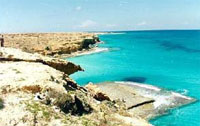|
  In ancient times Marsa Matrouh was called "Amounea" as it was the gateway to Siwa, home to a temple dedicated to the god "Amoun." Old references mention that Alexander the great was the one who built it. In ancient times Marsa Matrouh was called "Amounea" as it was the gateway to Siwa, home to a temple dedicated to the god "Amoun." Old references mention that Alexander the great was the one who built it.
There was also a palace for Cleopatra on the high hill overlooking the famous bay of Marsa Matrouh with its wide shore and smooth white sands extending for long distances and sloping gradually into the pure blue waters of the Mediterranean with the civilized mass of the city to the rear.
  Marsa Matrouh's port is located on a big circular bay where the sandy and rocky mountains located to the north form a natural barrier that protect it from the high sea waves and provide a calm and tranquil oasis.
Marsa Matrouh's port is located on a big circular bay where the sandy and rocky mountains located to the north form a natural barrier that protect it from the high sea waves and provide a calm and tranquil oasis.
As such, Marsa Matrouh has a natural port although it had no commercial value in the past.
  Marsa Matrouh is the ideal location from which to discover the numerous beaches and coves in the area.
Marsa Matrouh is the ideal location from which to discover the numerous beaches and coves in the area.
Marsa Matrouh has a group of
wonderful beaches and fabulous
turquoise water of the Mediterranean
and white sand that combines beauty
and magic.

   Beausite
beach Beausite
beach
Our private beach is famous for its white soft sands and calm transparent waters as the bay is protected from the high seas by a series of rocks forming a natural wave barrier.

  Alam
El Rom beach Alam
El Rom beach
It is located 12 k.m. to the east of
Matrouh.

  El
Aubayeed beach El
Aubayeed beach
It is about 18 k.m. to the west of
Matrouh.

   Aguiba
beach Aguiba
beach
Located 24 km from Matrouh with white sands, crystal clear blue waters and numerous natural caves.

 Rommel
beach Rommel
beach
Located2.5 km from Matrouh at Rommel Island in front of the eastern harbour of Marsa
Matrouh.

|